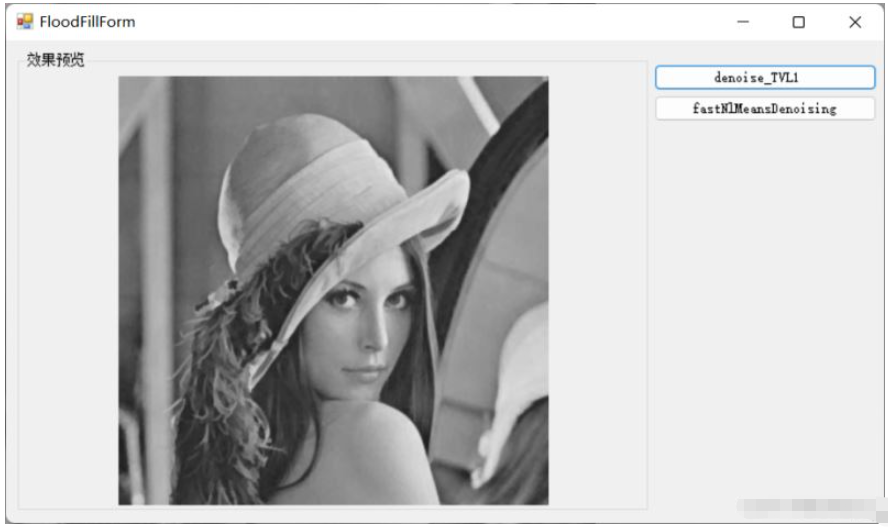OpenCV如何实现图像去噪算法
今天小编给大家分享一下OpenCV如何实现图像去噪算法的相关知识点,内容详细,逻辑清晰,相信大部分人都还太了解这方面的知识,所以分享这篇文章给大家参考一下,希望大家阅读完这篇文章后有所收获,下面我们一起来了解一下吧。
一、函数参考
1、Primal-dual算法
Primal-dual algorithm是一种用于解决特殊类型的变分问题的算法(即找到一个函数来最小化一些泛函)。

特别是由于图像去噪可以看作是变分问题,因此可以使用原始对偶算法进行去噪,这正是该算法所实现的。
cv::denoise_TVL1 (const std::vector< Mat > &observations, Mat &result, double lambda=1.0, int niters=30)
| observations | 该数组应包含要恢复的图像的一个或多个噪声版本。 |
| result | 这里将存储去噪图像。 无需预先分配存储空间,必要时会自动分配。 |
| lambda | 对应于上述公式中的 λ。 当它被放大时,平滑(模糊)的图像比细节(但可能有更多噪点)的图像更受欢迎。 粗略地说,随着它变小,结果会更加模糊,但会去除更多的异常值。 |
| niters | 算法将运行的迭代次数。 当然,越多的迭代越好,但是这个说法很难量化细化,所以就使用默认值,如果结果不好就增加它。 |
2、非局部均值去噪算法
使用非局部均值去噪算法,该方法基于一个简单的原理:将像素的颜色替换为相似像素颜色的平均值。 但是与给定像素最相似的像素根本没有理由靠近。 因此,扫描图像的大部分以寻找真正类似于想要去噪的像素的所有像素是合法的。执行图像去噪,并进行了多种计算优化。 噪声预期为高斯白噪声。
cv::cuda::fastNlMeansDenoising (InputArray src, OutputArray dst, float h, int search_window=21, int block_size=7, Stream &stream=Stream::Null()) cv::fastNlMeansDenoising (InputArray src, OutputArray dst, float h=3, int templateWindowSize=7, int searchWindowSize=21) cv::fastNlMeansDenoising (InputArray src, OutputArray dst, const std::vector< float > &h, int templateWindowSize=7, int searchWindowSize=21, int
针对彩色图像的 fastNlMeansDenoising 函数。
cv::cuda::fastNlMeansDenoisingColored (InputArray src, OutputArray dst, float h_luminance, float photo_render, int search_window=21, int block_size=7, Stream &stream=Stream::Null()) cv::fastNlMeansDenoisingColored (InputArray src, OutputArray dst, float h=3, float hColor=3, int templateWindowSize=7, int searchWindowSize=21)
针对图像序列的 fastNlMeansDenoising 函数。
cv::fastNlMeansDenoisingColoredMulti (InputArrayOfArrays srcImgs, OutputArray dst, int imgToDenoiseIndex, int temporalWindowSize, float h=3, float hColor=3, int templateWindowSize=7, int searchWindowSize=21) cv::fastNlMeansDenoisingMulti (InputArrayOfArrays srcImgs, OutputArray dst, int imgToDenoiseIndex, int temporalWindowSize, float h=3, int templateWindowSize=7, int searchWindowSize=21) cv::fastNlMeansDenoisingMulti (InputArrayOfArrays srcImgs, OutputArray dst, int imgToDenoiseIndex, int temporalWindowSize, const std::vector< float > &h, int templateWindowSize=7, int searchWindowSize=21, int normType=NORM_L2)
执行纯非局部方法去噪,没有任何简化,因此速度不快。
cv::cuda::nonLocalMeans (InputArray src, OutputArray dst, float h, int search_window=21, int block_size=7, int borderMode=BORDER_DEFAULT, Stream &stream=Stream::Null())
三、OpenCV源码
1、源码路径
opencv\modules\photo\src\denoise_tvl1.cpp
2、源码代码
#include "precomp.hpp"
#include <vector>
#include <algorithm>
#define ABSCLIP(val,threshold) MIN(MAX((val),-(threshold)),(threshold))
namespace cv{
class AddFloatToCharScaled{
public:
AddFloatToCharScaled(double scale):_scale(scale){}
inline double operator()(double a,uchar b){
return a+_scale*((double)b);
}
private:
double _scale;
};
using std::transform;
void denoise_TVL1(const std::vector<Mat>& observations,Mat& result, double lambda, int niters){
CV_Assert(observations.size()>0 && niters>0 && lambda>0);
const double L2 = 8.0, tau = 0.02, sigma = 1./(L2*tau), theta = 1.0;
double clambda = (double)lambda;
double s=0;
const int workdepth = CV_64F;
int i, x, y, rows=observations[0].rows, cols=observations[0].cols,count;
for(i=1;i<(int)observations.size();i++){
CV_Assert(observations[i].rows==rows && observations[i].cols==cols);
}
Mat X, P = Mat::zeros(rows, cols, CV_MAKETYPE(workdepth, 2));
observations[0].convertTo(X, workdepth, 1./255);
std::vector< Mat_<double> > Rs(observations.size());
for(count=0;count<(int)Rs.size();count++){
Rs[count]=Mat::zeros(rows,cols,workdepth);
}
for( i = 0; i < niters; i++ )
{
double currsigma = i == 0 ? 1 + sigma : sigma;
// P_ = P + sigma*nabla(X)
// P(x,y) = P_(x,y)/max(||P(x,y)||,1)
for( y = 0; y < rows; y++ )
{
const double* x_curr = X.ptr<double>(y);
const double* x_next = X.ptr<double>(std::min(y+1, rows-1));
Point2d* p_curr = P.ptr<Point2d>(y);
double dx, dy, m;
for( x = 0; x < cols-1; x++ )
{
dx = (x_curr[x+1] - x_curr[x])*currsigma + p_curr[x].x;
dy = (x_next[x] - x_curr[x])*currsigma + p_curr[x].y;
m = 1.0/std::max(std::sqrt(dx*dx + dy*dy), 1.0);
p_curr[x].x = dx*m;
p_curr[x].y = dy*m;
}
dy = (x_next[x] - x_curr[x])*currsigma + p_curr[x].y;
m = 1.0/std::max(std::abs(dy), 1.0);
p_curr[x].x = 0.0;
p_curr[x].y = dy*m;
}
//Rs = clip(Rs + sigma*(X-imgs), -clambda, clambda)
for(count=0;count<(int)Rs.size();count++){
transform<MatIterator_<double>,MatConstIterator_<uchar>,MatIterator_<double>,AddFloatToCharScaled>(
Rs[count].begin(),Rs[count].end(),observations[count].begin<uchar>(),
Rs[count].begin(),AddFloatToCharScaled(-sigma/255.0));
Rs[count]+=sigma*X;
min(Rs[count],clambda,Rs[count]);
max(Rs[count],-clambda,Rs[count]);
}
for( y = 0; y < rows; y++ )
{
double* x_curr = X.ptr<double>(y);
const Point2d* p_curr = P.ptr<Point2d>(y);
const Point2d* p_prev = P.ptr<Point2d>(std::max(y - 1, 0));
// X1 = X + tau*(-nablaT(P))
x = 0;
s=0.0;
for(count=0;count<(int)Rs.size();count++){
s=s+Rs[count](y,x);
}
double x_new = x_curr[x] + tau*(p_curr[x].y - p_prev[x].y)-tau*s;
// X = X2 + theta*(X2 - X)
x_curr[x] = x_new + theta*(x_new - x_curr[x]);
for(x = 1; x < cols; x++ )
{
s=0.0;
for(count=0;count<(int)Rs.size();count++){
s+=Rs[count](y,x);
}
// X1 = X + tau*(-nablaT(P))
x_new = x_curr[x] + tau*(p_curr[x].x - p_curr[x-1].x + p_curr[x].y - p_prev[x].y)-tau*s;
// X = X2 + theta*(X2 - X)
x_curr[x] = x_new + theta*(x_new - x_curr[x]);
}
}
}
result.create(X.rows,X.cols,CV_8U);
X.convertTo(result, CV_8U, 255);
}
}四、效果图像示例

原图

denoise_TVL1

以上就是“OpenCV如何实现图像去噪算法”这篇文章的所有内容,感谢各位的阅读!相信大家阅读完这篇文章都有很大的收获,小编每天都会为大家更新不同的知识,如果还想学习更多的知识,请关注蜗牛博客行业资讯频道。
免责声明:本站发布的内容(图片、视频和文字)以原创、转载和分享为主,文章观点不代表本网站立场,如果涉及侵权请联系站长邮箱:niceseo99@gmail.com进行举报,并提供相关证据,一经查实,将立刻删除涉嫌侵权内容。版权声明:如无特殊标注,文章均为本站原创,转载时请以链接形式注明文章出处。















评论